This Guest Article for REVITALIZATION was written by Michelle Connor.
In a temporary manufacturing facility in Everett, Washington, walls, secured by an overhead crane, ‘fly’ into place. The end-product will be a proof-of-concept modular prototype which will be the first in the United States made from cross-laminated timber.
Cross-laminated timber, or CLT, is a mass timber wood panel product manufactured by gluing together layers of lumber stacked in alternating perpendicular directions. The result is a lightweight yet strong structural building material that holds up well against fire, earthquakes and temperature changes.
CLT and modular construction have been used in combination successfully in Europe for more than 20 years. Forterra is leveraging that experience for a new model designed to create a sustainable supply chain from sustainable forestry to affordable housing.
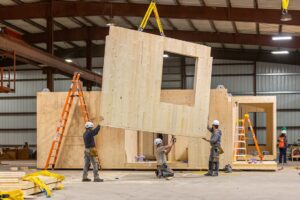
An expert crew from Zaugg AG Rohrbach in Switzerland demonstrates the technology of modular cross-laminated timber at Forterra’s temporary manufacturing site in Everett. Creating living wage jobs in rural areas is a key facet of Forterra’s Forest to Home initiative.
Forterra’s Forest to Home initiative begins with local, responsibly harvested timber, with CLT produced by local labor, in a soon-to-be state-of-the-art facility in rural Darrington, Washington. Darrington is 75 miles northeast of Seattle and on the western shoulder of the Cascade Mountains, with roots in the timber industry.
The initiative is designed to increase the supply of attainable homes in local communities and utilizes a limited equity co-op ownership financial structure to alleviate the initial financial burden for homebuyers and maintain affordability over the long haul.
“Forterra’s Forest to Home initiative focuses on driving benefits across our ecosystem – both natural and human,” said Forterra Board Chair, Beth Birnbaum. “By aligning incentives, we can maintain healthy working forests, create meaningful jobs in small rural towns and anchor underserved communities in rapidly changing neighborhoods. It’s a win-win-win for the environment, economic development and social equity.”
Forterra is a nonprofit and an unconventional land trust. We’ve learned that conserving habitat and supporting communities are intertwined, and that meaningful strategies to address the climate crisis must ensure that people and nature thrive together.
Forterra’s Forest to Home initiative can bring attainable and long-term affordable homes to Washington communities and renewed economic vitality to rural areas while contributing to the restoration regional working forests. In short, this new model is an overdue overhaul of the traditional building supply chain, making it local and sustainable to address ongoing challenges communities face here and around the world. It’s the start of something different.
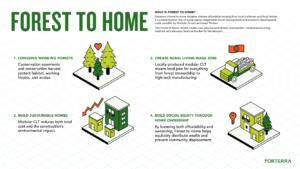
Cross-laminated timber is the catalyst behind Forterra’s Forest to Home initiative that begins with conservation harvests and ends with sustainable, attainable homes while building social equity.
“Along every facet of the Forest to Home initiative, we are wringing cost from and localizing the supply chain to make homes that are affordable, beautiful and sustainable,” said Tobias Levey, Forterra’s Vice President of Real Estate Transactions.
“We’ve seen median home prices soar over the past decade in Washington and people commuting greater distances and at greater personal and environmental cost. We see Forest to Home as a way to mitigate this problem, and one that is scalable to help meet the increasing demand for affordable housing in Washington,” he added.
At the center of this initiative is the workhorse manufacturing campus, the Darrington Wood Innovation Center, scheduled to break ground in 2022. The 93.6-acre facility will include a sawmill, kiln, boiler, mass timber and modular assembly facility.
It also provides space for mechanical, engineering and plumbing along with finish carpenters and other trades. This enables the Darrington Wood Innovation Center to provide nearly complete homes which can be transported to their destination, significantly simplifying and speeding the construction process.
The Darrington facility is a $120 million investment that is expected to spur local and regional growth. Fully implemented, it’s expected that the Forest to Home initiative will revitalize rural Washington by creating more than 1000 permanent jobs, in sectors such as forest management and manufacturing, and nearly 1000 in indirect and construction jobs throughout the Pacific Northwest.
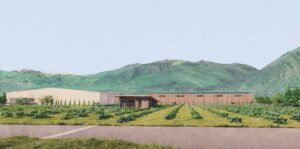
This $120 million facility will house a sawmill, a CLT/glulam and modular manufacturing plant and vast assembly spaces where local workers will create modular CLT homes.
“As a timber town, we are excited to be the innovation hub for this emerging high-tech wood products industry,” said Dan Rankin, Town of Darrington Mayor.
“The Darrington Wood Innovation Center will spread economic diversity throughout our region by creating 122 new permanent jobs that require a wide spectrum of skillsets and will allow folks to carry-on our legacy trades while adapting to modern technologies,” he added.
Though the complete environmental benefits are still being quantified, modular cross-laminated timber has real environmental benefits. Wood manufacturing is far less CO2 intensive than traditional concrete and steel construction.
One goal of the Forest to Home initiative is to sequester millions of tons of CO2 emissions through the conservation of 100,000 acres of forest and building thousands of units of affordable housing and large industrial buildings from CLT.
The work has already begun. While the Darrington Wood Innovation Center is being built, Forterra is in various stages of planning for four community-driven, modular CLT projects throughout the region that will create homes and commercial space for Black- and immigrant-owned businesses and hard-hit rural areas in Washington.
These projects are led by the communities in Tacoma, Tukwila, Roslyn, and Hamilton, Washington.
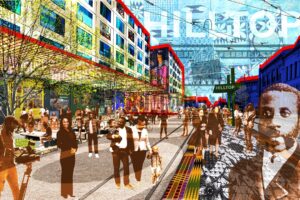
Forterra’s Hilltop project in Tacoma, Washington is community-led by members of the historically Black Hilltop community.
In Hilltop, a historically Black neighborhood in Tacoma, Forterra was invited in by the community in 2019. Working collaboratively with Hilltop residents, Forterra acquired a long-shuttered Rite Aid at the center of the business district near public transportation, including a newly launched light rail line.
Following conversations with Hilltop stakeholders, working with local community partner, Fab-5, and a citizen’s advisory council made up of Black residents of Hilltop, Forterra began collaborating with the community to design a development that would meet community stakeholder needs.
“I believe that Forterra is leading the way in how developers should be coming into a community—by working alongside residents, thinking outside the box for creative and new ways to bring in sustainable housing and by preserving natural resources that will help improve the quality of life in our neighborhoods,” said Brendan Nelson, Executive Director of Hilltop Action Coalition.
“I think Forterra has set the tone and become an example for other developers looking to come into any community, particularly Hilltop: Do your homework, connect, engage and grow together,” he continued.
Over the course of many community conversations, the Hilltop community identified increasing opportunities for home ownership as one of the community’s primary needs, to address the ongoing rapid displacement of its residents.
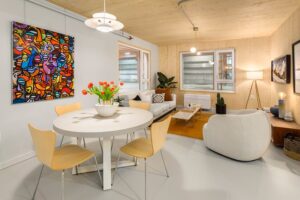
A finished living room and dining room in a two-bedroom home from Forterra’s cross-laminated timber modular prototype from February 2022.
In addition, the community wanted a development that would center Black-owned businesses and the art and culture of the Hilltop community.
The community-led process honed the concept of a mixed-use development that includes 23,000 square feet of commercial space with a priority for Black-owned businesses and 287,000 square feet of ownership and rental homes.
Half of these will be targeted for 60 percent of area median income, with a priority for Hilltop’s residents. Hilltop will make use of units from the Darrington Wood Innovation Center, making it the second project of the Forest to Home initiative.
“We are connecting Washington’s communities and landscapes in a process that improves the outlook for everyone,” said Birnbaum. “We are striving to generate healthy working forests, economic development in rural areas and social equity through homeownership.”
All images courtesy of Forterra.
ABOUT THE AUTHOR:
 Michelle Connor is President and CEO of Seattle, Washington-based Forterra.
Michelle Connor is President and CEO of Seattle, Washington-based Forterra.
The non-profit Forterra works to steward land for community and environmental well-being.
She has played a part in more than 400 transactions worth $500 million and provided executive leadership in all phases of public policy, community engagement, negotiations, fundraising and innovative finance.

